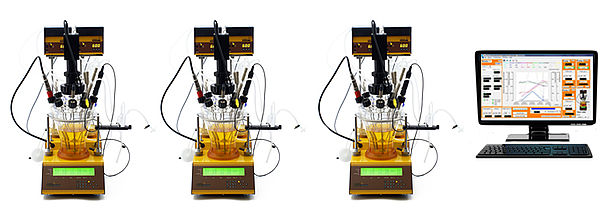Laboratory fermenter and bioreactor MINIFOR: The solitary team player in parallel processes
Why is MINIFOR perfectly suited for your parallel processes?

Each unit stays independent
“The MINIFOR fermenter-bioreactor is not only a solitary worker. You can also let it work in a team, in parallel cultures, without loss of independence in parameter regulation.”
Each LAMBDA MINIFOR unit is equipped with a control panel and display and shows at a single glance the set values and actual values as well as the high and low-alarms of each parameter. All parameters are regulated locally inside each fermenter unit.
This allows fast and precise parameter regulation and never having to worry about leaving a vessel unattended. A further advantage is that in case there are problems with one unit, the other units will still keep running. This is not the case when problems occur in a tower-controlled system.
I’d like to compare the data of the different runs. What about data saving, data comparison and remote control?
“MINIFOR is not a lone fighter – it also connects to others to exchange data.”
Several MINIFOR-units can be connected and controlled by fermentation control software on a PC. This allows you to have control of all connected fermenters remotely and to compare the culture parameters. The connection of several MINIFOR-units to the control software does not require additional licenses.
How important is the slow-down in parameter regulation when running 12 reactors in parallel?
“The number of connected fermenter units to the PC has no influence on the quality of the parameter measurement and regulation!”
An important aspect to consider – which, however, does not play a role in the LAMBDA MINIFOR parallel system because each MINIFOR fermenter comes with its proper regulation unit that measures and controls all parameters locally. As a consequence the quality of the measurement and regulation is not affected by long transmission times and dead times in regulation.
Of course this does not hinder the transmission of all fermentation data of each fermenter to be saved on your PC!
What happens, if the measurement and regulation of one parameter or even the whole unit fails?
“Everything is exchangeable – even the exceptional MINIFOR!”
A failure occurred? All other bioreactor units of your parallel system continue working, as if nothing had happened!
Not only can the fermenter vessel be removed from the base unit in seconds but also the peristaltic pumps and additional accessories. This offers decisive advantages for maintenance and customer service:
Each pump or the whole MINIFOR-unit can be quickly and easily exchanged.
The parallel system adapts to your premises
“MINIFOR only requires minimal space, for example in the last corner of your lab or it can also stand in file on your laboratory bench – it’s your choice!”
In contrast to traditional systems, the MINIFOR-units do not need to stand next to each other in parallel processes, but can be distributed in your labs, depending on your lab space availability.
How much space does a MINIFOR unit require?
“Do you still have space for an A4 sheet of paper? Then, there’s still place for the MINIFOR!”
Footprint: approximately an A4 sheet of paper
Dimensions: 22 cm x 38 cm x 40 cm (W x H x D)
MINIFOR on the move!
“Watch your MINIFOR because this handy fermenter can be carried away by a single person!”
Are you facing reorganization? Don't worry, MINIFOR goes along with (almost) everything: Weight per MINIFOR unit: 7.5 kg.
Furthermore, the reliable LAMBDA laboratory peristaltic pumps can be also used anytime as stand-alone instruments without the fermenter.
How can I work with such a compact instrument?
“MINIFOR does not drive you crazy – you also do not need to book a relaxation course.”
Although LAMBDA MINIFOR only takes minimal laboratory bench surface, the connections are easily accessible: The side necks for the probes and ports are arranged at an angle of 30°. The gained space allows for easy sterility.